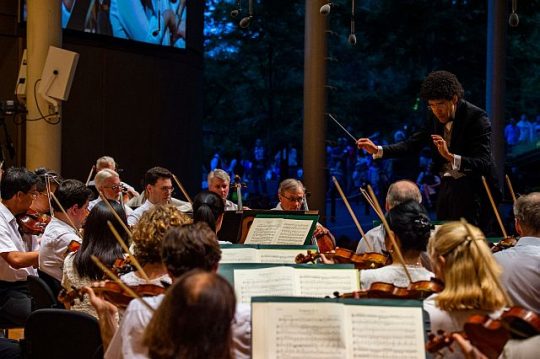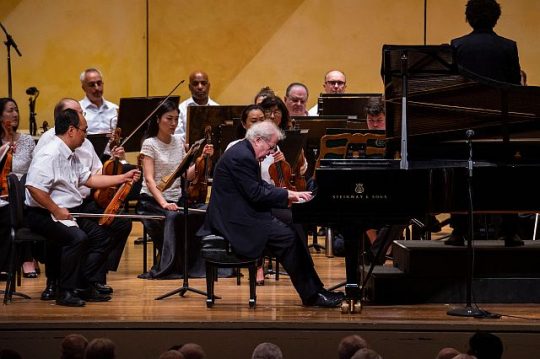
Dimitry Ivashchenko (Rocco), Elza van den Heever (Leonore) and Russell Thomas, (Florestan) in Lyric Opera’s ‘Fidelio.’ (Photo by Todd Rosenberg)
4 stars – Highly recommended
Lyric Opera of Chicago expounds on freedom of expression in this captivating, uplifting production of Beethoven’s Fidelio.
Florestan (Russell Thomas) is being held as a political prisoner for speaking against the corruption of prison administrator Don Pizarro (Brian Mulligan).
Don Pizarro wants Florestan silenced for good and employs the aid of his director of security, Rocco (Dimitry Ivashchenko), who refuses to murder Florestan but agrees to dig a secret grave if his boss will actually do the killing.
Florestan’s wife Leonore (Elza van den Heever) manages to disguise herself as a young man, getting a job at the prison with the intention of finding a way to free her husband.
While working at the prison, Rocco’s daughter, Marzelline (Sydney Mancasola), a secretary in his office, falls in love with Fidelio who is actually Leonore in disguise. (The opera used to be known as “Leonore.”)
Leonore uses Marzelline’s infatuation with Fidelio to gain favor with Rocco who ultimately engages Fidelio to help with the digging of Florestan’s grave. That gives Leonore the opportunity needed to at least see her husband and try to affect an escape.
Fidelio has a happy ending and thus is a story of Good triumphing over Evil. Most importantly, it is a story of hope combined with the courage to speak truth to power and to stand up to tyranny and oppression in order to right a wrong.

Elza van den Heever, Russell Thomas and company in “Fidelio”at Lyric Opera of Chicago. (Photo by Todd Rosenberg)
Fidelio is the only opera written by Beethoven, which in spite of the storyline, has a lightness that provides each character with lyrical arias and artful contrapuntal trios. It also offers the outstanding Lyric Chorus led by Michael Black, beautifully harmonious choral pieces.
The musicality of the overture has resulted in four versions of various lengths that have become part of the musical canon for orchestras worldwide since it was written. The Lyric has chosen to present the shorter version conducted by Enrique Mazzola in order to proceed with the dramatic performance.
The set design of Alexander V. Nichols is comprised of a gigantic, roughly forty-foot square, two-level cube of assembled gray steel pipes and screens, that rotates to display both the prison office and holding cells.
In Act II, the cube is reset to depict the subterranean basement where the “secret prisoner” is confined. The prison office is decorated with typewriters, filing cabinets, and water coolers while workers and prisoners are costumed in modern dress presenting an overall twentieth century vibe.
Nichols also utilizes projected images during the overture to suggest Leonore’s decision to take on the persona of Fidelio. Onstage video monitors are used to create a more contemporary atmosphere, and in the case of Florestan, to project his inner turmoil and torture induced fantasies.
It’s interesting to see how easily this 18th Century music and story transforms to modern times making this a potentially very accessible opera for younger audiences or those who may be uninitiated to this theatrical genre.
This is aided by the fact that there are no traditional recitatives but rather short bits of easily digestible spoken dialogue that bring the story together between musical numbers.
Twenty-first century audiences will appreciate the portrayal of a strong female hero and the allusions to political oppression that continues to be perpetrated throughout the world.
DETAILS: “Fidelio” is at the Lyric Opera House, 20 N. Wacker Dr., Chicago, on select dates through October 10, 2024. Running time: 2 hours, 25 minutes with one intermission. For tickets and other information visit Lyric Opera.
Reno Lovison
For more shows visit Theatre in Chicago



